An Improved Integrated Numerical Simulation Method to Study Main Controlling Factors of EUR and Optimization of Development Strategy
Abstract
:1. Introduction
Motivation
2. Model Development
2.1. Geologic Modeling
- One-dimensional well seismic analysis: the scope of the target area is determined, wellhead coordinates and well trajectory are input in the model; then, the interpretation of basic data is carried out such as strata division, structural interpretation, and geomechanical parameters interpretation with the logging data or 3D seismic data;
- Two-dimensional structure model: the regional structure model is built on the basis of the layer system and tectonic situation;
- Three-dimensional geological attribute and mechanical model: the geological model is built with the phase controlling attribute modeling method, and the geostress model is built with the finite element method for the fine modeling of the 3D geostress field.
2.2. Fracture Propagation Simulation
- Segmental perforation parameter input: based on the fracturing construction summary reports, the perforation location, depth, segmentation and clustering number, and other information are input in the model;
- Fracturing pumping program design: fracturing fluid and proppant properties are input, and the construction curve is divided with the fracturing seconds data;
- Simulation of hydraulic fracture propagation: based on the geological model and actual engineering parameters, the finite element method is used to simulate the hydraulic fracture propagation in consideration of the stress interference between segments, and the simulation results are verified with micro seismic monitoring data and pumping construction curves.
2.3. Numerical Simulation
- Unstructured grid generation: equivalent treatment of the fracture’s size and seepage capacity shall be carried out according to the actual fracture shape, and the fracture reconstruction area and unmodified area shall be zoned;
- Establishes the numerical simulation of the gas well, platform, and reservoir;
- Reserves and history matching: respectively, match the reserves of adsorbed gas and free gas, and then carry out production history matching;
- Optimization of developmental technology strategy: different developmental technology indicators can be optimized directly from the engineering parameters with the production/EUR as the targets.
3. Model Implementation
3.1. The Basic Parameter Setting of Integrated Model
3.2. An Improved Integrated Numerical Simulation Method
- (1)
- Since the formation attributes are not calculated after fracture propagation simulation with conventional software, a water injection operation is added to consider the saturation and pressure changes during fracturing. Then a shut-in operation is added to simulate the soaking process in the shale gas reservoir.
- (2)
- Add a certain thickness of non-reservoir grid below the target layer to consider the gravity differentiation effect of water in high permeability fractures.
- (3)
- The fracture and matrix is divided into different zones to consider the different stress sensitive parameters and relative permeability laws in the cracks and matrix (Figure 2).
3.3. Analysis of Main Controlling Factors Affecting Production Capacity
4. Results
4.1. Optimization of Well Trajectory Direction
4.2. Optimization of Volume of Fracturing Fluid
4.3. Optimization of Proppant Mass
4.4. Optimization of Well Spacing
4.5. Optimization of Horizontal Stage Length
4.6. The Production Allocation and the Optimization of Development Strategy
4.7. The Study of Soak Rules
5. Discussion
- The integrated geological and engineering model of the shale gas platform has been formed, mainly including hydraulic fracture propagation simulation, numerical simulation, and optimization.
- The actual integrated simulation of a platform is carried out and the fitting effect is pretty good through the production historical fitting.
- The influence degree of the main controlling geological and engineering factors in shale gas production is defined; the cluster spacing and proppant mass are the two most important factors, and well spacing is an unimportant engineering factor. The porosity and matrix permeability are the two most important factors in the geological factors.
- Engineering factors: cluster spacing > proppant mass > horizontal stage length > volume of fracturing fluid > flow rate > well spacing;
- Geological factors: porosity > matrix permeability > principal stress difference > minimum horizontal principal stress > Young’s modulus > water saturation.
- According to the simulations, the recommended liquid strength of the platform is 25–30 m3/m, the recommended proppant mass is 2.5 t/m, the optimal well spacing is 350–400 m, the recommended the angle between well trajectory and maximum principal stress is 75°, the optimum production allocation is 8 × 104 m3/d, and its stable period is 25 years.
Author Contributions
Funding
Data Availability Statement
Acknowledgments
Conflicts of Interest
References
- Shabro, V.; Torres-Verdin, C.; Javadpour, F. Numerical Simulation of Shale-Gas Production: From Pore-Scale Modeling of Slip-Flow, Knudsen Diffusion, and Langmuir Desorption to Reservoir Modeling of Compressible Fluid. In Proceedings of the North American Unconventional Gas Conference and Exhibition, The Woodlands, TX, USA, 14–16 June 2011. [Google Scholar] [CrossRef] [Green Version]
- Ye, D.; Yin, C.; Li, Y.; Wang, S.; Qin, G.; Chen, H. Numerical Simulation of Shale Gas Development Based on Complex Fracture Network Growth. In Proceedings of the SPE Energy Resources Conference, Port of Spain, Trinidad and Tobago, 9–11 June 2014. [Google Scholar] [CrossRef]
- Velikanov, I.; Isaev, V.; Bannikov, D.; Tikhonov, A.; Semin, L.; Belyakova, L.; Kuznetsov, D. New Fracture Hydrodynamics and In-Situ Kinetics Model Supports Comprehensive Hydraulic Fracture Simulation. In Proceedings of the SPE Europec featured at 80th EAGE Conference and Exhibition, Copenhagen, Denmark, 11–14 June 2018. [Google Scholar] [CrossRef]
- Peng, Y.; Zhao, J.; Sepehrnoori, K.; Li, Y.; Yu, W.; Zeng, J. Study of the Heat Transfer in Wellbore during Acid/Hydraulic Fracturing Based on Semi-analytical Transient Model. SPE J. 2019, 24, 877–890. [Google Scholar] [CrossRef]
- Li, M.; Hu, X.; Zhou, F.; Wang, B.; Han, S.; Huang, G. Three-dimensional Numerical Simulation of Interaction of Hydraulic Fracture and Natural Fracture Using the Cohesive Zone Finite Element Method. In Proceedings of the SPE/AAPG/SEG Latin America Unconventional Resources Technology Conference, Virtual, 16–18 November 2020. [Google Scholar] [CrossRef]
- Perfetto, R.; Tealdi, L. Hydraulic Fracturing as a Development Strategy-Successful Case Histories from the Congo Basin: A Matter of Technology and Risk Attitude. In Proceedings of the SPE Nigeria Annual International Conference and Exhibition, Lagos, Nigeria, 30 July–1 August 2013. [Google Scholar] [CrossRef]
- Jinzhou, Z.; Yu, P.E.N.G.; Yongming, L.I.; Zhisheng, T.I.A.N. Applicable conditions and analytical corrections of plane strain assumption in the simulation of hydraulic fracturing. Pet. Explor. Dev. 2017, 44, 454–461. [Google Scholar]
- Al Shehhi, H.A.A.; Bernadi, B.; Al Shamsi, A.B.Z.B.; Al Hammadi, S.J.; Alawadhi, F.O.; Mohamed, I.N.; Al Bairaq, A.M.; Al Hosani, M.A.; Abdullayev, A.; Roopal, A. Advanced Well Completion Strategies to Improve Gas Production Deliverability in Marginal Tight Gas Reservoirs from an Onshore Abu Dhabi Gas Field. In Proceedings of the Abu Dhabi International Petroleum Exhibition & Conference, Abu Dhabi, United Arab Emirates, 15–18 November 2021. [Google Scholar] [CrossRef]
- Yong, R.; Wu, J.; Shi, X.; Zhuang, X.; Wen, H.; Luo, Y. Development Strategy Optimization of Ning201 Block Longmaxi Shale Gas. In Proceedings of the SPE International Hydraulic Fracturing Technology Conference and Exhibition, Muscat, Oman, 16–18 October 2018. [Google Scholar] [CrossRef]
- Belhaj, H.A.; Dhabi, A.; Mnejja, M. Hydraulic Fracture Simulation of Two-Phase Flow: Discrete Fracture Modelling/Mixed Finite Element Approach. In Proceedings of the SPE Reservoir Characterisation and Simulation Conference and Exhibition, Abu Dhabi, United Arab Emirates, 9–11 October 2011. [Google Scholar] [CrossRef]
- Wei, S.; Jin, Y.; Liu, X.; Xia, Y. The Optimization of Infill Well Fracturing Using an Integrated Numerical Simulation Method of Fracturing and Production Processes. In Proceedings of the Abu Dhabi International Petroleum Exhibition & Conference, Abu Dhabi, United Arab Emirates, 15–18 November 2021. [Google Scholar] [CrossRef]
- Fang, S.; Xiong, H.; Wang, B.; Ma, L.; Rao, X.; Wu, Y. The Influence of Infill Well-Caused Fracture Interference on Shale Gas Production and Recovery: A Comprehensive Numerical Simulation Study. In Proceedings of the SPE/AAPG/SEG Asia Pacific Unconventional Resources Technology Conference, Virtual, 16–18 November 2021. [Google Scholar] [CrossRef]
- Li, Y.; Wei, C.; Qin, G.; Lu, Y.; Luo, K. Optimizing Hydraulic Fracturing Design for Shale Gas Production through Numerical Simulations. In Proceedings of the SPE International Production and Operations Conference & Exhibition, Doha, Qatar, 14–16 May 2012. [Google Scholar] [CrossRef]
- Liang, H.; Tang, H.; Qin, J.; Li, Y.; Zhou, X.; Zhang, L. Multi-Scale Investigations on the Geometries of Hydraulic Fractures in Conglomerate Reservoirs. In Proceedings of the International Petroleum Technology Conference, Riyadh, Saudi Arabia, 12 February 2022. [Google Scholar] [CrossRef]
- Andreev, A.; Astafyev, V.; Samoilov, M. Integrated Approach to Multistage Fracturing Design. In Proceedings of the SPE Symposium: Hydraulic Fracturing in Russia. Experience and Prospects, Virtual, 22–24 September 2020. [Google Scholar] [CrossRef]
- Francos, J.P.; Wagner, F.; Coppo, R.; Santiago, E. Optimizing Well Spacing of Multi Fractured Tight Gas Wells in Argentina’s Lajas Formation through High Resolution Simulation: Barrosa Norte Field Case Study. In Proceedings of the SPE Latin America and Caribbean Petroleum Engineering Conference, Buenos Aires, Argentina, 17–19 May 2017. [Google Scholar] [CrossRef]
- Bian, X.; Li, S.; Jiang, T.; Zuo, L.; Zhong, G. A Workflow to Simulate Flow Back Progress of Fractured Shale Gas Wells. In Proceedings of the 55th U.S. Rock Mechanics/Geomechanics Symposium, Virtual, 18–25 June 2021. [Google Scholar]
- Xu, K.; Sun, Z.; Wang, S.; Wang, Y. Integrate “sweet spot” seismic prediction with microseismic monitoring to apply to lacustrine shale in Sichuan Basin of China. In Proceedings of the SEG/AAPG International Meeting for Applied Geoscience & Energy, Houston, TX, USA, 28 August–1 September 2022. [Google Scholar] [CrossRef]
- Wang, L.; Yao, Y.; Wang, K.; Adenutsi, C.D.; Zhao, G. Combined Application of Unsupervised and Deep Learning in Absolute Open Flow Potential Prediction: A Case Study of the Weiyuan Shale Gas Reservoir. In Proceedings of the SPE/AAPG/SEG Asia Pacific Unconventional Resources Technology Conference, Virtual, 16–18 November 2021. [Google Scholar] [CrossRef]
- Zeng, L.; Zheng, Y.; Zou, L. Fracturing Technology of Real Time Control Guarantees Highly Efficient Exploitation of Shale in Weiyuan Gas-Field, SW China. In Proceedings of the SPE Russian Petroleum Technology Conference, Virtual, 26–29 October 2020. [Google Scholar] [CrossRef]
- Akita, E.; Moghanloo, R.G.; Davudov, D.; Tinni, A. A Systematic Approach for Upscaling of the EOR Results from Lab-Scale to Well-Scale in Liquid-Rich Shale Plays. In Proceedings of the SPE Improved Oil Recovery Conference, Tulsa, OK, USA, 14–18 April 2018. [Google Scholar] [CrossRef]
- Ibrahim, A.F.; Ibrahim, M.; Chester, P. Developing New Soaking Correlation for Shale Gas Wells. In Proceedings of the SPE/AAPG/SEG Unconventional Resources Technology Conference, Denver, CO, USA, 22–24 July 2019. [Google Scholar] [CrossRef]
- Alqahtani, M.H.; Ertekin, T. Shale Gas Reservoir Development Strategies using Complex Specified Bottom-hole Pressure Well Architectures. In Proceedings of the SPE Kingdom of Saudi Arabia Annual Technical Symposium and Exhibition, Dammam, Saudi Arabia, 24–27 April 2017. [Google Scholar] [CrossRef]
- Saleem, W.A.; Baber, S.; Jafri, M.O. Shale Gas Field: Exploration, Exploitation and Development Strategies Globally. In Proceedings of the SPE Saudi Arabia Section Technical Symposium and Exhibition, Al-Khobar, Saudi Arabia, 21–24 April 2014. [Google Scholar] [CrossRef]
- Mitschanek, M.; Prohaska, M.; Thonhauser, G. Integrated Planning to Optimize Field Development Strategies and Real Time Decision Making During Project Execution for Large Scale Shale Resource Projects. In Proceedings of the SPE Intelligent Energy International Conference and Exhibition, Aberdeen, Scotland, UK, 6–8 September 2016. [Google Scholar] [CrossRef]
- Porlles, J. Strategy for the Development of Shale Gas in Peruvian Fields. In Proceedings of the SPE Latin America and Caribbean Petroleum Engineering Conference, Maracaibo, Venezuela, 21–23 May 2014. [Google Scholar] [CrossRef]
- Younus, H.M.B.; Kazmi, F.; Ali, W.; Khan, M.N.; Khalid, A. Development Strategy Planning for a Shale Reservoir. In Proceedings of the PAPG/SPE Pakistan section Annual Technical Conference, Islamabad, Pakistan, 26–27 November 2014. [Google Scholar] [CrossRef]
- Alsadoun, R. Integrated Resource Estimation and Field Development Workflow for Unconventional Reservoirs Using Reservoir Simulation and Economic Analysis Tools: A Case Study from a Shale Well in Saudi Arabia. In Proceedings of the SPE Annual Technical Conference and Exhibition, Dallas, TX, USA, 24–26 September 2018. [Google Scholar] [CrossRef]
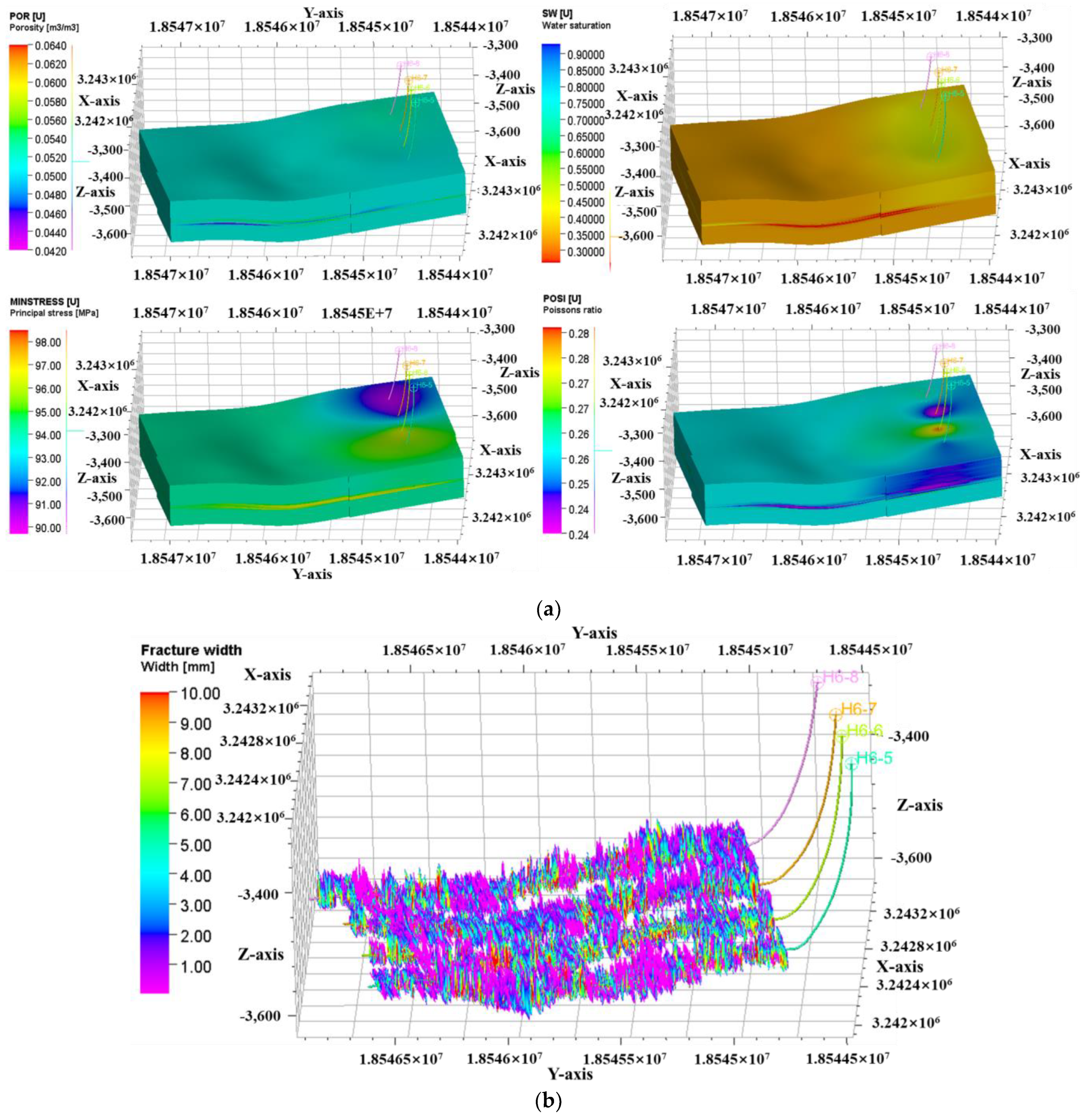



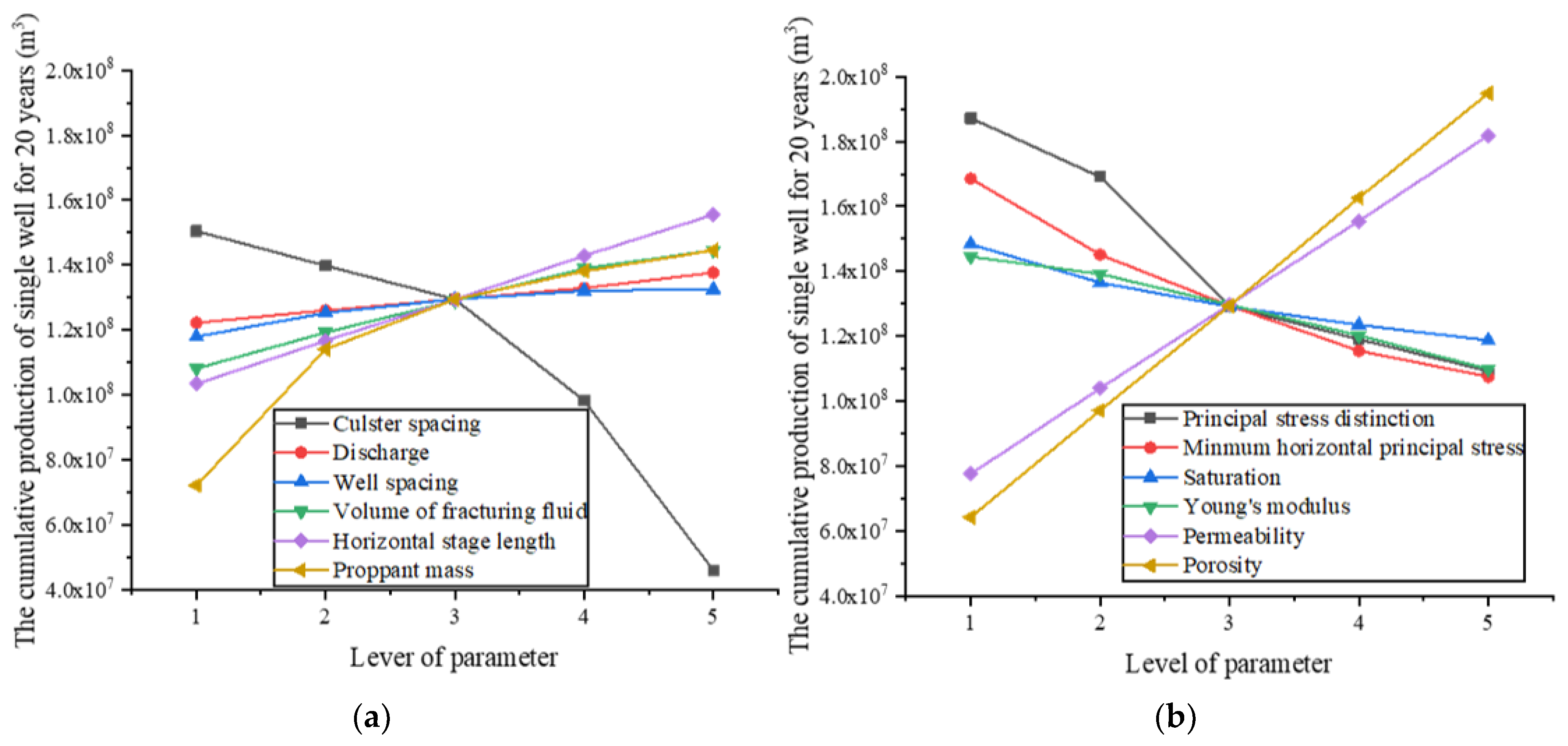

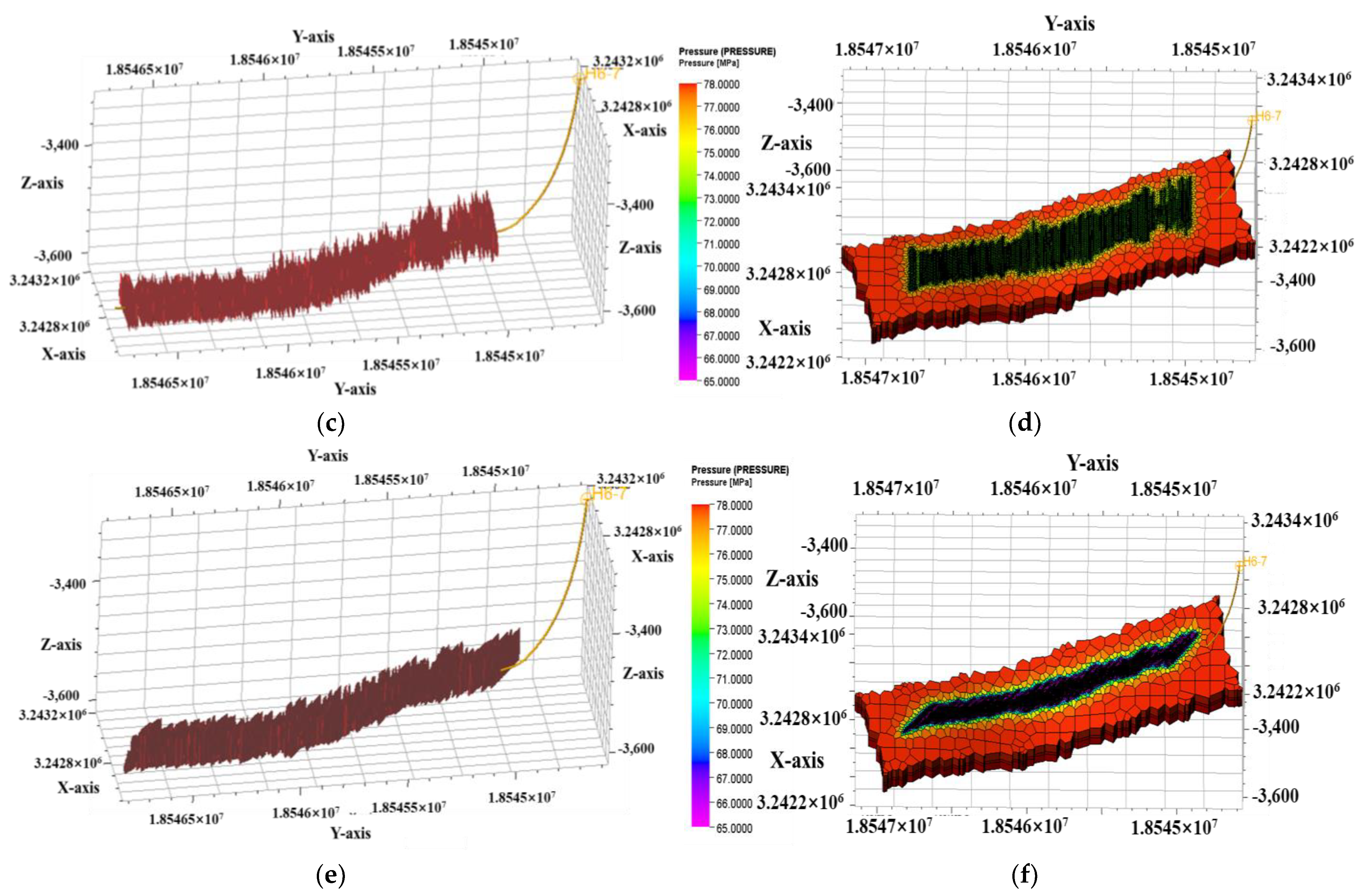
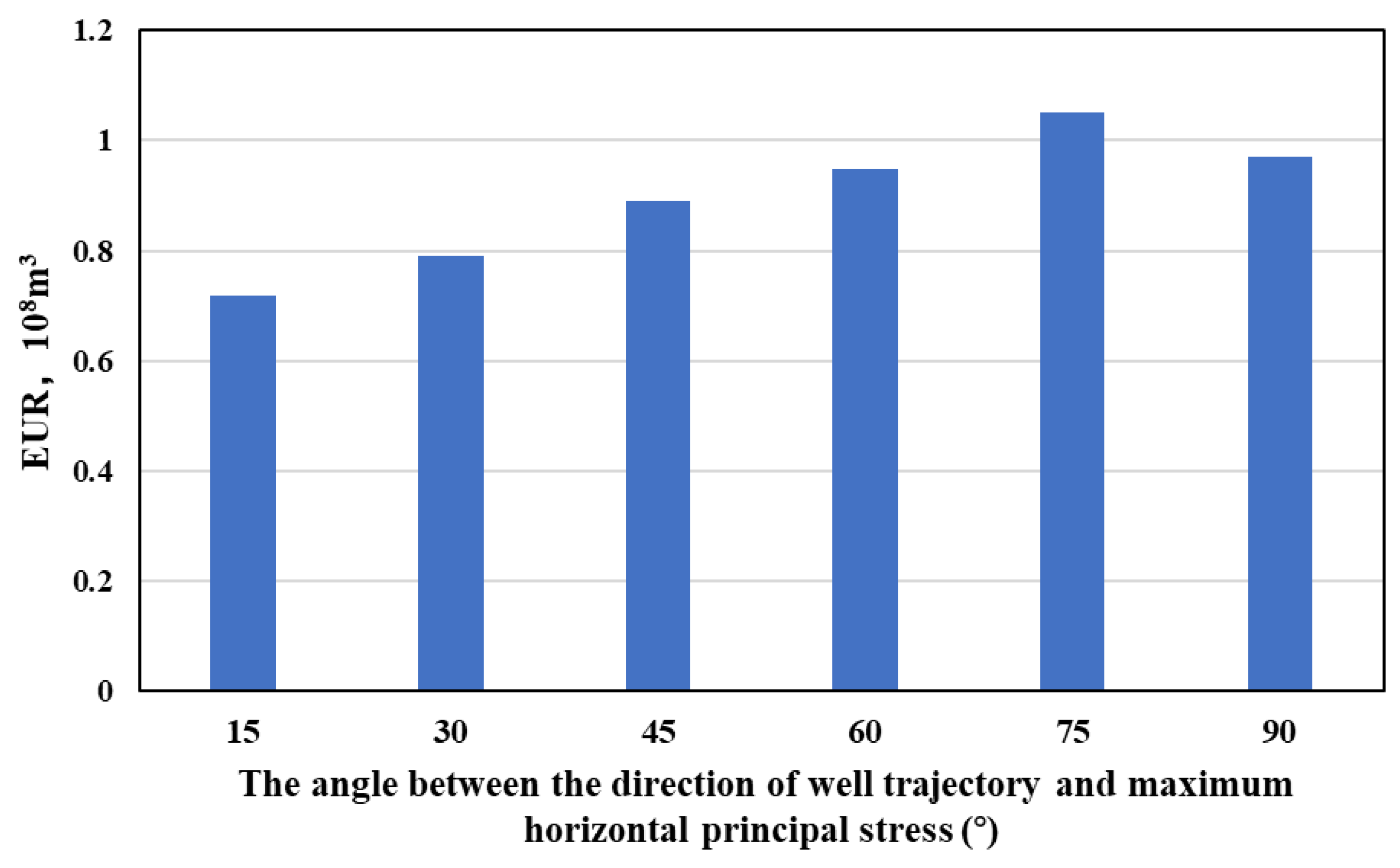


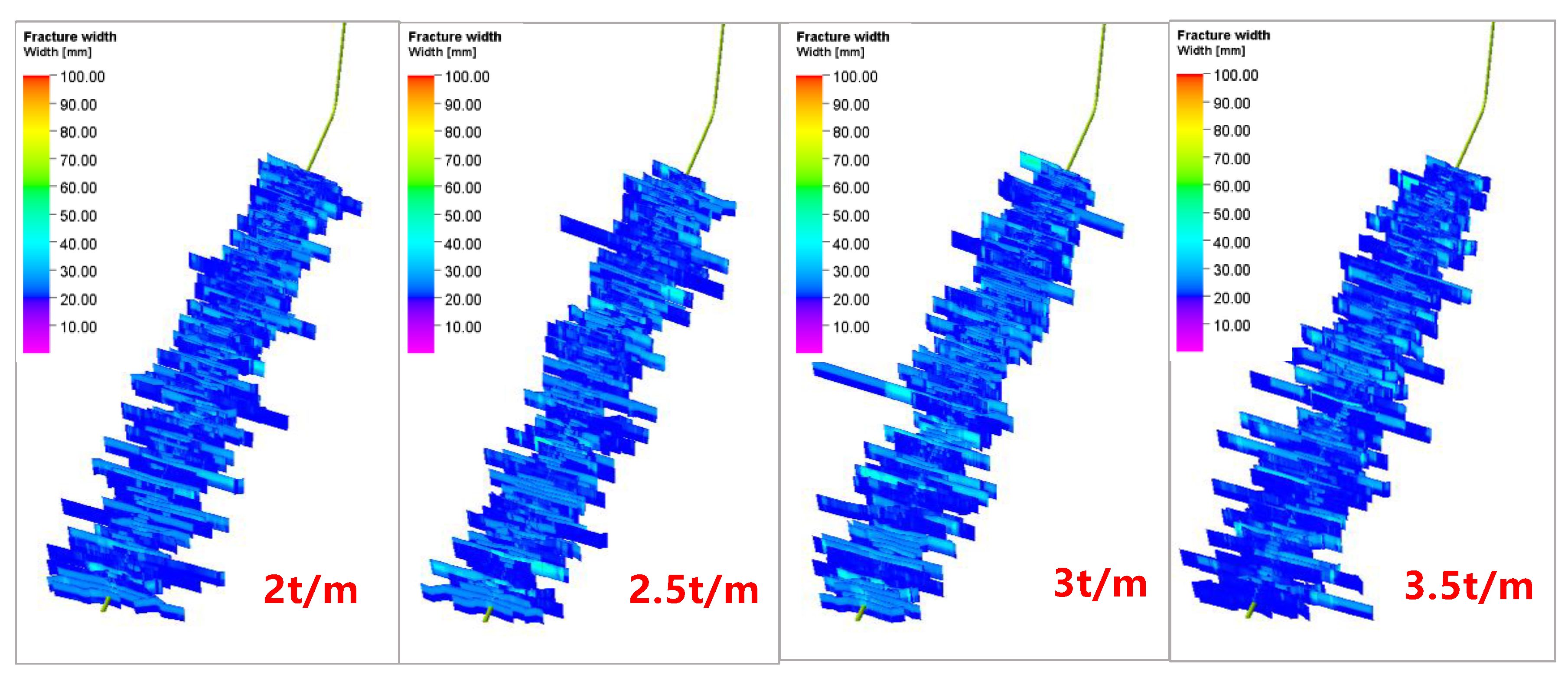

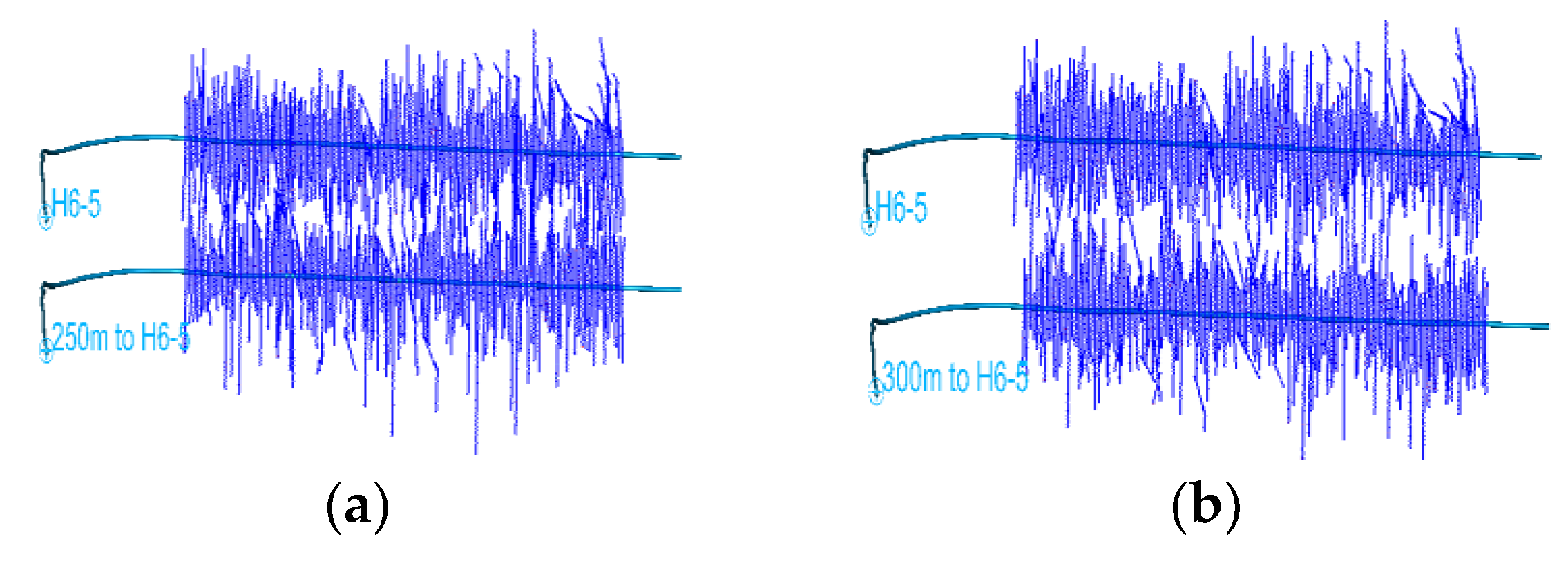
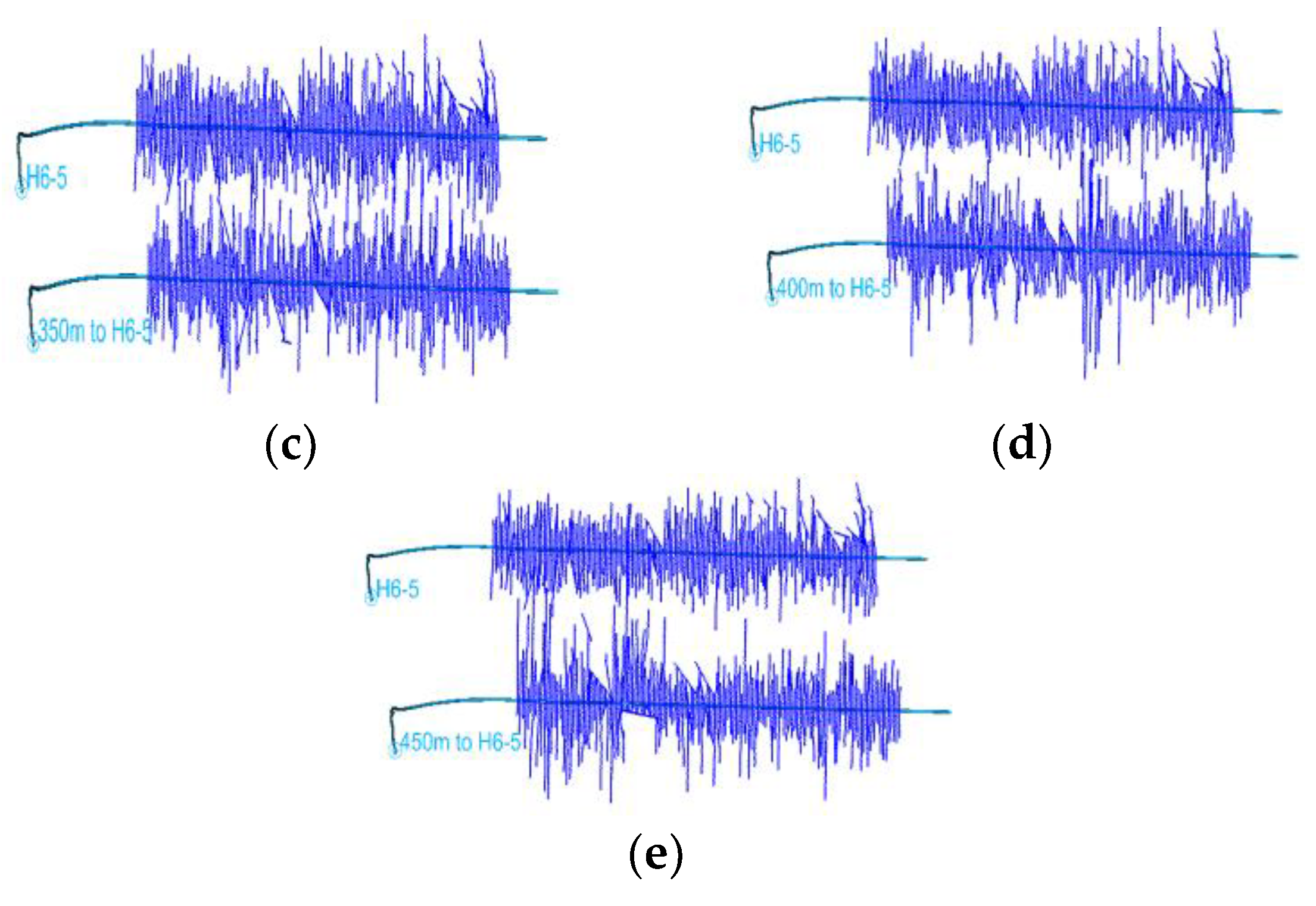


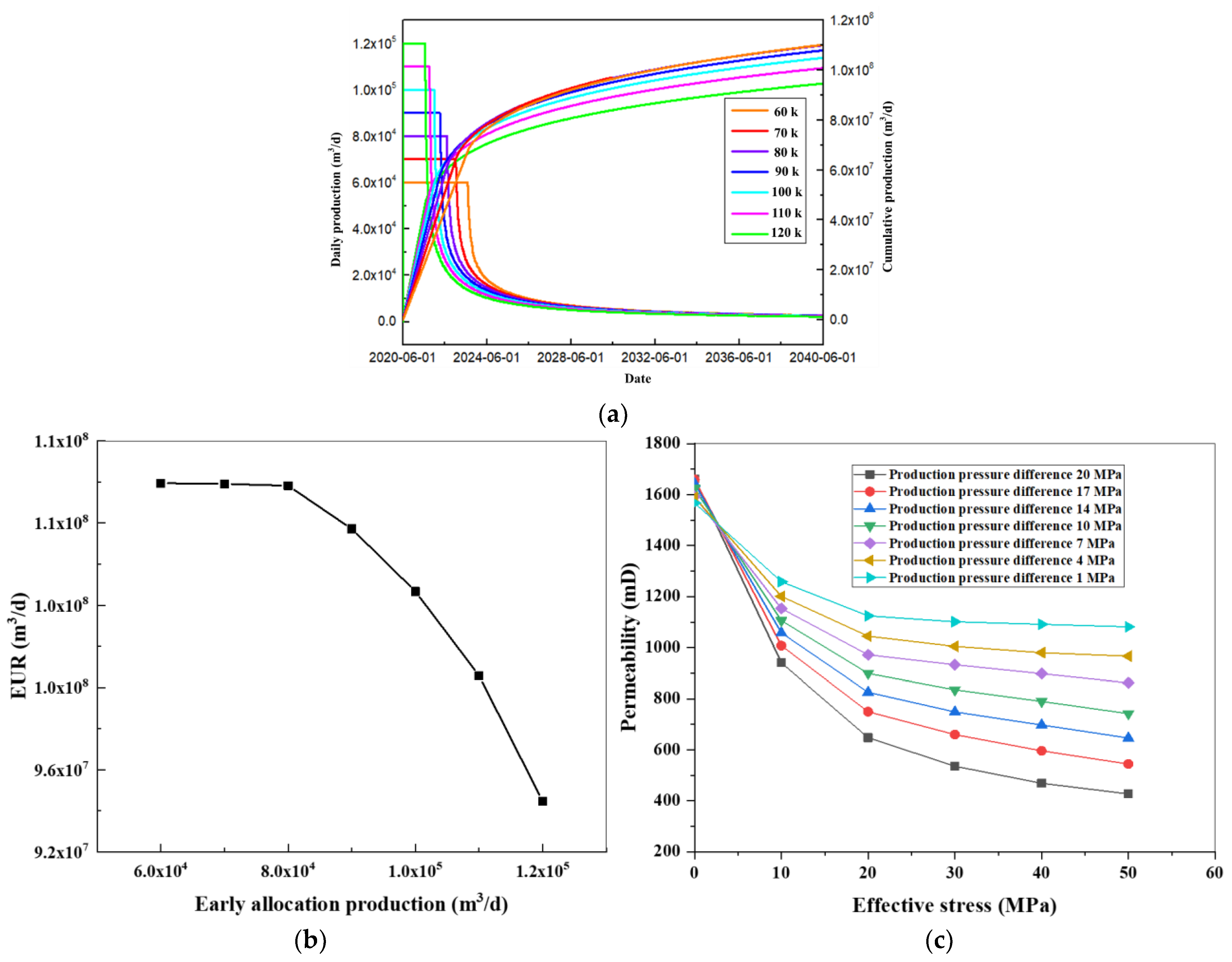
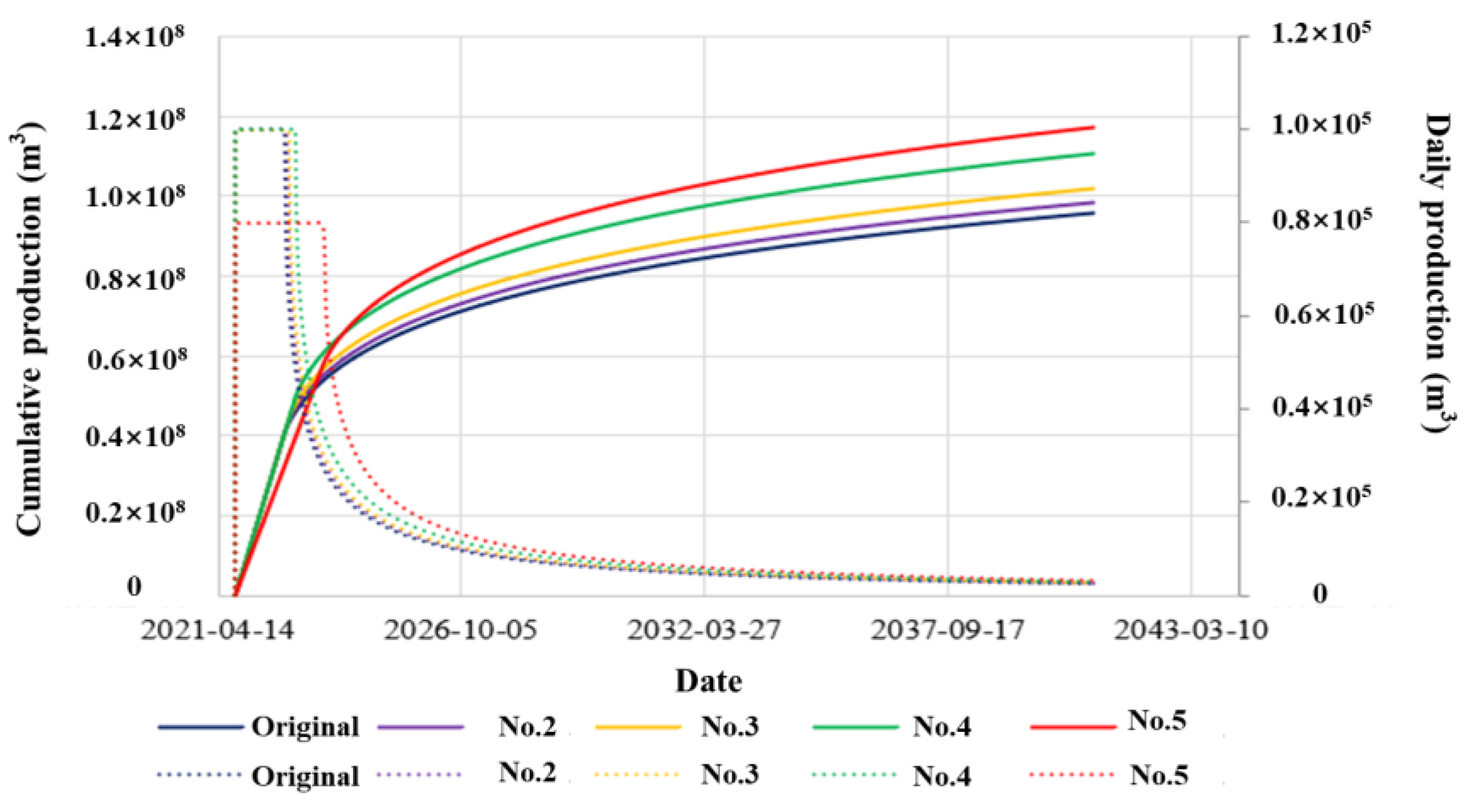

| Engineering Parameter | Geological Parameter | ||||
|---|---|---|---|---|---|
| Average proppant mass per unit length (t/m) | 2.43 | Young’s modulus (GPa) | 42.6 | Matrix permeability (nD) | 50–200 |
| Discharge (m3/min) | 9–18 | Poisson’s ratio | 0.25 | porosity | 0.05 |
| Cluster | 6 | Average minimum horizontal principal stress (MPa) | 90.7 | Average gas content (m3/t) | 8.375 |
| cluster spacing (m) | 9.71 | Average maximum horizontal principal stress (MPa) | 102.4 | Average Langmuir pressure (MPa) | 4 |
| Volume of fracturing fluid pumped per unit length (m3/m) | 27.16 | Average Langmuir volume (mg/g) | 3.2 | ||
| Factors | Each Factor Corresponds to EUR, 108 m3 | |||||
|---|---|---|---|---|---|---|
| Volume of Fracturing Fluid | Proppant Mass | Cluster Spacing | Flow Rate | Well Spacing | Horizontal Stage Length | |
| Level value 1 | 0.99 | 0.73 | 1.51 | 1.11 | 1.19 | 1.04 |
| Level value 2 | 1.20 | 1.15 | 1.40 | 1.23 | 1.26 | 1.17 |
| Level value 3 | 1.30 | 1.30 | 1.30 | 1.30 | 1.30 | 1.30 |
| Level value 4 | 1.38 | 1.39 | 0.99 | 1.33 | 1.33 | 1.43 |
| Level value 5 | 1.41 | 1.45 | 0.47 | 1.35 | 1.34 | 1.56 |
| EUR range factor | 0.42 | 0.72 | 1.05 | 0.25 | 0.15 | 0.52 |
| Factors | Each Factor Corresponds to EUR, 108 m3 | |||||
|---|---|---|---|---|---|---|
| Porosity | Matrix Permeability | Water Saturation | Young’s Modulus | Minimum Horizontal Principal Stress | Principal Stress Difference | |
| Level value 1 | 0.65 | 0.78 | 1.48 | 1.45 | 1.88 | 1.69 |
| Level value 2 | 0.98 | 1.04 | 1.37 | 1.40 | 1.69 | 1.45 |
| Level value 3 | 1.30 | 1.30 | 1.30 | 1.30 | 1.30 | 1.30 |
| Level value 4 | 1.63 | 1.56 | 1.24 | 1.20 | 1.19 | 1.17 |
| Level value 5 | 1.95 | 1.82 | 1.20 | 1.10 | 1.10 | 1.08 |
| EUR range factor | 1.30 | 1.04 | 0.29 | 0.35 | 0.78 | 0.61 |
| Strategy | Cumulative Production (m3) | The Increase of EUR | Relative Increase | Note |
|---|---|---|---|---|
| No. 1 | 9.36 × 107 | 100.00% | Original | |
| No. 2 | 9.75 × 107 | 104.17% | 4.17% | Angle |
| No. 3 | 1.02 × 108 | 108.97% | 4.81% | Well spacing |
| No. 4 | 1.12 × 108 | 119.66% | 10.68% | Volume of fracturing fluid |
| No. 5 | 1.17 × 108 | 125.00% | 5.34% | Production allocation |
Disclaimer/Publisher’s Note: The statements, opinions and data contained in all publications are solely those of the individual author(s) and contributor(s) and not of MDPI and/or the editor(s). MDPI and/or the editor(s) disclaim responsibility for any injury to people or property resulting from any ideas, methods, instructions or products referred to in the content. |
© 2023 by the authors. Licensee MDPI, Basel, Switzerland. This article is an open access article distributed under the terms and conditions of the Creative Commons Attribution (CC BY) license (https://creativecommons.org/licenses/by/4.0/).
Share and Cite
Du, Y.; Liu, H.; Sun, Y.; Sheng, S.; Wei, M. An Improved Integrated Numerical Simulation Method to Study Main Controlling Factors of EUR and Optimization of Development Strategy. Energies 2023, 16, 2011. https://doi.org/10.3390/en16042011
Du Y, Liu H, Sun Y, Sheng S, Wei M. An Improved Integrated Numerical Simulation Method to Study Main Controlling Factors of EUR and Optimization of Development Strategy. Energies. 2023; 16(4):2011. https://doi.org/10.3390/en16042011
Chicago/Turabian StyleDu, Yihe, Hualin Liu, Yuping Sun, Shuyao Sheng, and Mingqiang Wei. 2023. "An Improved Integrated Numerical Simulation Method to Study Main Controlling Factors of EUR and Optimization of Development Strategy" Energies 16, no. 4: 2011. https://doi.org/10.3390/en16042011






